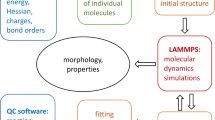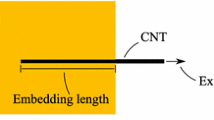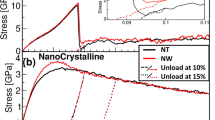Abstract
Many applications, ranging from neural prosthetics and cardiac rhythm management systems to organics-based flexible display, can benefit from the engineering of parylene-metal-parylene structures via selective deposition. Despite several experimental studies, the mechanism responsible for this selective deposition is not clear and is the subject of the current paper. Towards this goal, we used the quantum semiempirical Hamiltonian (QSH) solver coupled to a molecular dynamic (MD) model, which is particularly suited to study parylene-metal interactions due to its ability to determine the different pathways of the transformations involving making and breaking of chemical and physical bonds. The simulation results of selective deposition of various parylene chains on titanium dioxide and gold surfaces are presented. Time-dependent bond orders were used to quantify the deposition process. The mechanism of metal atom adhesion to parylene was also discussed to provide insights into the formation of defects in metal/parylene interfaces.












Similar content being viewed by others
References
HajjHassan M, Chodavarapu V, Musallam S (2008) NeuroMEMS: neural probe microtechnologies. Sensors 8:6704–6726. doi:10.3390/s8106704
Rodger DC, Fong AJ, Li W, Ameri H, Ahuja AK, Gutierrez C, Lavrov I, Zhong H, Menon PR, Meng E, Burdick JW, Roy RR, Edgerton VR, Weiland JD, Humayun MS, Tai YC (2008) Flexible parylene-based multielectrode array technology for high-density neural stimulation and recording. Sens Actuators B 132:449–460. doi:10.1016/j.snb.2007.10.069
Lobodzinski SS, Laks M (2009) New material for implantable cardiac leads. J Electrocard 42:566–573. doi:10.1016/j.jelectrocard.2009.07.019
Choia MC, Kimb Y, Ha CS (2008) Polymers for flexible displays: from material selection to device applications. Prog Polym Sci 33:581–630. doi:10.1016/j.progpolymsci.2007.11.004
Hildebrand HF, Blanchemain N, Mayer G, Chai F, Lefebvre M, Boschin F (2006) Surface coatings for biological activation and functionalization of medical devices. Surf Coat Technol 200:6318–6324. doi:10.1016/j.surfcoat.2005.11.086
Senkevich JJ, Wiegand CJ, Yang GR, Lu TM (2004) Selective deposition of ultrathin poly(p-xylene) films on dielectrics versus copper surfaces. Chem Vap Deposition 10:247–249. doi:10.1002/cvde.200304179
Vaeth KM, Jensen KF (2000) Transition metals for selective chemical vapor deposition of parylene-based polymers. Chem Mater 12:1305–1313. doi:10.1021/cm990642p
Chen HY, Lai JH, Jiang X, Lahann J (2008) Substrate-selective chemical vapor deposition of reactive polymer coatings. Adv Mater 20:3474–3408. doi:10.1002/adma.200800455
Stoliarov SI, Westmoreland PR, Nyden MR, Forneyb GP (2003) A reactive molecular dynamics model of thermal decomposition in polymers: I. Poly(methyl methacrylate). Polymer 44:883–894. doi:10.1016/S0032-3861(02)00761-9
Stewart JJP (2007) Optimization of parameters for semiempirical methods V: modification of NDDO approximations and application to 70 elements. J Mol Model 13:1173–1213. doi:10.1007/s00894-007-0233-4
Frenklach M, Carmer CS (1999) Molecular Dynamics using combined quantum and empirical forces: applications to surface reactions. Adv Classical Trajectory Methods 4:27–63
Vasenkov AV, Sengupta D, Frenklach M (2009) Multiscale modeling catalytic decomposition of hydrocarbons during carbon nanotube growth. J Phys Chem B 113:1877–1882. doi:10.1021/jp808346h
Stewart JJP (1990) Semiempirical molecular orbital methods. In: Lipkowitz KB, Boyd DB (eds) Reviews in Computational Chemistry. VCH, New York, pp 45–81. doi:10.1002/9780470125786.ch2
Pamur HO, Halicioǧlu T (1976) Evaluation of morse parameters for metals. Phys Stat Sol A 37:695–699. doi:10.1002/pssa.2210370242
Beeman J (1976) Some multistep methods for use in molecular dynamics calculations. J Comput Phys 20:130–139. doi:10.1016/0021-9991(76)90059-0
Berendsen HJC, Postma JPM, van Gunsteren WF, DiNola A, Haak JR (1984) Molecular-Dynamics with coupling to an external bath. J Chem Phys 81:3684–3690. doi:10.1063/1.448118
Puddephatt RJ (1979) Gold chemistry today. Endeavour 3:78–81. doi:10.1016/0160-9327(79)90070-X
Thompson SJ, Lewis SP (2006) Revisiting the (110) surface structure of TiO2: a theoretical analysis. Phys Rev B 73:073403(1-4). doi:10.1103/PhysRevB.73.073403
Schmidbaur H (ed) (1999) Gold: progress in chemistry, biochemistry and technology. Wiley, Chichester, pp 349–427
Schmidbaur H (2000) The aurophilicity phenomenon: a decade of experimental findings, theoretical concepts and emerging applications. Gold Bull 33:3–10
Stewart JJP (2008) Application of the PM6 method to modeling the solid state. J Mol Model 14:499–535. doi:10.1007/s00894-008-0299-7
Kahouli A, Sylvestre A, Ortega L, Jomni F, Yangui B, Maillard M, Berge B, Robert JC, Legrand J (2009) Structural and dielectric study of parylene C thin films. Appl Phys Lett 94:152901(1–3)doi:10.1063/1.3114404
Wu H (1999) Chemical property calculation through JavaScript and applications in QSAR. Molecules 4:16–27. doi:10.3390/40100016
Beard RB, Hung BN, Schmukler R (1992) Biocompatibility considerations at stimulating electrode interfaces. Ann Biomed Eng 20:395–410. doi:10.1007/BF02368539
Lyon JT, Andrews L (2006) Electron deficient carbon-titanium triple bonds: formation of triplet XC/TiX3 methylidyne complexes. Inorg Chem 45:9858–9863. doi:10.1021/ic0610379
Vastine BA, Hall MB (2009) The molecular and electronic structure of carbon–hydrogen bond activation and transition metal assisted hydrogen transfer. Coord Chem Rev 253:1202–1218. doi:10.1016/j.ccr.2008.07.015
Fanelli AJ, Maeland AJ, Rosan AM, Crissey RK (1985) Use of hydride-forming metals as renewable chemical reagents: the dehydrogenation of isobutane to isobutene. J Chem Soc Chem Commun 1:8–10
Perutza RN, Braunb T (2006) Transition metal-mediated C–F bond activation. In: Mingos DMP, Parkin G (eds) Comprehensive organometallic chemistry III: from fundamentals to applications. Elsevier, Dordrecht, pp 725–758
Charlton G, Howes PB, Nicklin CL, Steadman P, Taylor JSG, Muryn CA, Harte SP, Mercer J, McGrath R, Norman D, Turner TS, Thornton G (1997) Relaxation of TiO2(110)-(1 × 1) using surface X-ray diffraction. Phys Rev Lett 78:495–498. doi:10.1103/PhysRevLett.78.495
Lindsay R, Wander A, Ernst A, Montanari B, Thornton G, Harrison NM (2005) Revisiting the surface structure of TiO2(110): a quantitative low-energy electron diffraction study. Phys Rev Lett 94:246102(1–4). doi:10.1103/PhysRevLett.94.246102
Author information
Authors and Affiliations
Corresponding author
Rights and permissions
About this article
Cite this article
Vasenkov, A.V. Atomistic modeling of parylene-metal interactions for surface micro-structuring. J Mol Model 17, 3219–3228 (2011). https://doi.org/10.1007/s00894-011-0996-5
Received:
Accepted:
Published:
Issue Date:
DOI: https://doi.org/10.1007/s00894-011-0996-5




